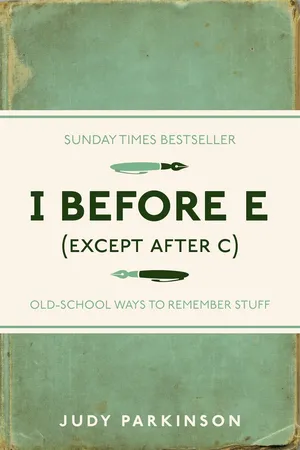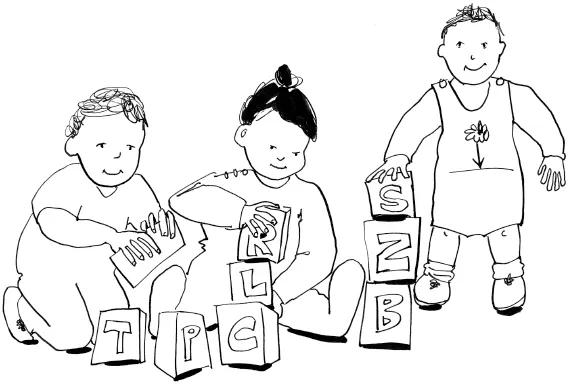
- English
- ePUB (mobile friendly)
- Available on iOS & Android
eBook - ePub
About this book
Ever find yourself struggling to remember simple facts and rules? Is the ever increasing pace of life and glut of information challenging your memory? I Before E (Except After C) is full of memory aids to help you out. From well known rhymes such as the popular 'Thirty days hath September, April, June and November', memorable sayings including 'Spring forward, fall back', and mnemonics such as 'Richard of York Gave Battle in Vain', to a selection of more modern methods of boosting one's failing memory. I Before E is the definitive guide to help you to unjumble your mind and improve your ability to recall names, dates, facts, figures and events, and contains all the mnemonics you'll ever need to know.
Frequently asked questions
Yes, you can cancel anytime from the Subscription tab in your account settings on the Perlego website. Your subscription will stay active until the end of your current billing period. Learn how to cancel your subscription.
At the moment all of our mobile-responsive ePub books are available to download via the app. Most of our PDFs are also available to download and we're working on making the final remaining ones downloadable now. Learn more here.
Perlego offers two plans: Essential and Complete
- Essential is ideal for learners and professionals who enjoy exploring a wide range of subjects. Access the Essential Library with 800,000+ trusted titles and best-sellers across business, personal growth, and the humanities. Includes unlimited reading time and Standard Read Aloud voice.
- Complete: Perfect for advanced learners and researchers needing full, unrestricted access. Unlock 1.4M+ books across hundreds of subjects, including academic and specialized titles. The Complete Plan also includes advanced features like Premium Read Aloud and Research Assistant.
We are an online textbook subscription service, where you can get access to an entire online library for less than the price of a single book per month. With over 1 million books across 1000+ topics, we’ve got you covered! Learn more here.
Look out for the read-aloud symbol on your next book to see if you can listen to it. The read-aloud tool reads text aloud for you, highlighting the text as it is being read. You can pause it, speed it up and slow it down. Learn more here.
Yes! You can use the Perlego app on both iOS or Android devices to read anytime, anywhere — even offline. Perfect for commutes or when you’re on the go.
Please note we cannot support devices running on iOS 13 and Android 7 or earlier. Learn more about using the app.
Please note we cannot support devices running on iOS 13 and Android 7 or earlier. Learn more about using the app.
Yes, you can access I Before E (Except After C) by Judy Parkinson in PDF and/or ePUB format, as well as other popular books in Languages & Linguistics & Grammar & Punctuation. We have over one million books available in our catalogue for you to explore.
Information
1
The English Language

The Alphabet
Before we could read the complete works of Shakespeare, as children we first had to learn the alphabet. Some of us will have recited the letters to the tune of ‘Twinkle, Twinkle, Little Star’, a method made famous by Big Bird from the TV programme Sesame Street.
The song was first copyrighted in 1835 by Charles Bradlee, a Boston music publisher, who called it: ‘The ABC, a German air with variations for the flute with an easy accompaniment for the pianoforte.’
a–b–c–d–e–f–g,
h–i–j–k–l–m–n–o–p,
q–r–s–t–u–v,
w–x–y and z.
Now I know my A, B, Cs,
next time won’t you sing with me?
Because the letters l–m–n–o–p have to be sung twice as fast as the rest of the letters in the rhyme, some children have mistakenly assumed that ‘elemenopee’ is a word. For the rhyme to work with the Z, you have to use the American pronunciation of ‘zee’ rather than ‘zed’.
If you didn’t sing the ABC to the tune of ‘Twinkle, Twinkle, Little Star’ then you might have used the tune of ‘Baa, Baa, Black Sheep’ instead, which has a very similar rhythm and melody.

The following ABC memory rhyme entitled ‘The Tragical Death of A, Apple Pie, Who Was Cut in Pieces, and Eaten By Twenty-Six Gentlemen, With Whom All Little People Ought to be Very Well Acquainted’, was a popular way of teaching the alphabet to youngsters in the nineteenth century, though it dates back at least as far as the reign of Charles II (1660–85).
A was an apple pie
B bit it,
C cut it,
D dealt it,
E eats it,
F fought for it,
G got it,
H had it,
I inspected it,
J jumped for it,
K kept it,
L longed for it,
M mourned for it,
N nodded at it,
O opened it,
P peeped in it,
Q quartered it,
R ran for it,
S stole it,
T took it,
U upset it,
V viewed it,
W wanted it,
X, Y and Z all wished for and had a piece in hand.
The Five Vowels
The English alphabet has five soft vowels: A E I O U. This sequence of letters generally tends to roll off the tongue quite naturally, but for anyone who has trouble remembering the order of vowels, here are a couple of useful phrases:
Ann’s Egg Is On Us
Anthony’s Ego Is Over Used

Parts of Speech
After learning the alphabet, the next step is to come up with coherent sentences. The rhyme below categorizes each of the parts of speech, giving a clear example of the different type of word. It dates back to 1855 and was written by David B. Tower and Benjamin F. Tweed:
Three little words you often see
Are articles: a, an and the.
A noun’s the name of any thing,
As: school or garden, toy or swing.
Adjectives tell the kind of noun,
As: great, small, pretty, white or brown.
Verbs tell of something being done:
To read, write, count, sing, jump or run.
How things are done, the adverbs tell,
As: slowly, quickly, badly, well.
Conjunctions join the words together,
As: men and women, wind or weather.
The preposition stands before
A noun as: in or through a door.
The interjection shows surprise
As: ‘Oh, how pretty!’ or ‘Ah! How wise!’
The whole are called the parts of speech,
Which reading, writing, speaking teach.

A different rhyme called ‘The Parts of Speech’ is similarly pithy, and serves as another useful reminder of the different components of the English language. The origin of these verses is unknown.
Every name is called a noun,
As field and fountain, street and town.
In place of noun the pronoun stands,
As he and she can clap their hands.
The adjective describes a thing,
As magic wand and bridal ring.
The verb means action, something done –
To read, to write, to jump, to run.
How things are done, the adverbs tell,
As quickly, slowly, badly, well.
The preposition shows relation,
As in the street, or at the station.
Conjunctions join, in many ways,
Sentences, words, or phrase and phrase.
The interjection cries out, ‘Hark!
I need an exclamation mark!’
Through poetry, we learn how each
Of these make up the Parts of Speech.

What’s a Preposition?
After the alphabet and parts of speech come more tec...
Table of contents
- Cover
- Epigraph page
- Title page
- Copyright page
- Contents
- Introduction
- 1. The English Language
- 2. To Spell or Not to Spell
- 3. Think of a Number
- 4. Geographically Speaking
- 5. Animal, Vegetable, Mineral
- 6. Time and the Calendar
- 7. The Sky at Night and by Day
- 8. The World of Science
- 9. Britain: A Brief History
- 10. World History
- 11. Musical Interlude
- 12. Foreign Tongues
- 13. Religious Matters
- 14. The Human Body
- 15. Life-Saving Tips
- 16. The World of Work
- 17. A Miscellany of Mnemonics
- Select Bibliography